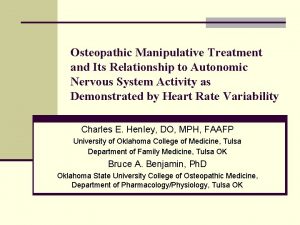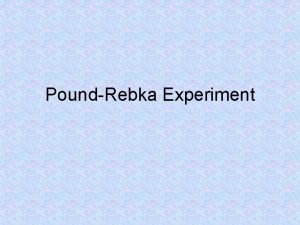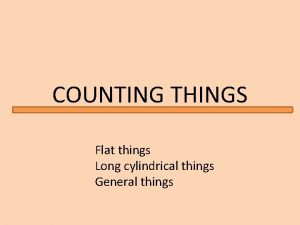Manipulative experiment Treatment It refers to the things




































- Slides: 36

Manipulative experiment Treatment (處理) It refers to the things that are being compared e. g. drug 1 vs. drug 2 Experimental unit (實驗單位)/Experimental subjects (被實驗者) The basic unit that is exposed to the treatments e. g. patients, rats Response (反應) The random variable that is expected to be affected by treatments e. g. blood pressure, survival

Experimental design: independent samples f 1 m 2 m 3 m 1 f 2 m 1 m 4 f 2 m 2 f 4 m 3 f 3 f 4 m 4 f 1

Experimental design: paired samples – before vs after f 1 m 2 m 3 f 1 m 1 f 2 f 3 f 4 Before m 2 m 4 Drug 1 or 2 m 3 m 1 f 2 f 3 f 4 After m 4

Experimental design: paired samples – simultaneous testing f 1 m 2 Drug 1 m 3 m 1 f 2 f 3 f 4 m 4 Drug 2

Experimental design: paired samples – block design f 1 m 2 m 3 m 1 f 2 m 4 f 1 m 3 f 4 m 2 f 2 m 1 f 3 Pair 1 Pair 2 Pair 3 Pair 4 f 3 f 4 m 4 Match for gender height weight age

Commonly used experimental designs Independent samples (Complete randomization) Paired samples

Analysis of Variance (ANOVA) Compare means of multiple populations More than two populations: ANOVA Two populations: ANOVA or two-sample t test The null and alternative hypotheses are: at least one pair of μ’s is not equal

ANOVA assumptions Ø The k samples represent independent random samples drawn from k populations with means μ 1, μ 2, . . , μk. Ø Each of the k populations is normally distributed Ø The k populations have the same variance, This is called “homogeneity of variance” assumption (recall the equal variance assumption in two-sample t test)

Does diet affect lifespan? What are the null and alternative hypotheses? What are the treatments? What are the response variables? What are the experimental units? Are experimental units randomly assigned to the treatments? Unlimited 90% diet 80% diet

Unlimited 90% diet 80% diet 2. 5 2. 7 3. 1 2. 9 i = 1, 2, …, k 2. 3 2. 9 3. 8 j = 1, 2, …, n 1. 9 3. 7 3. 9 2. 4 3. 5 4. 0

Deviation The deviation of an observation from the grand mean can be partitioned into two components: Deviation from an observation to the grand mean Deviation from the group mean to the grand mean Deviation from an observation to its group mean

Sums of Squares (SS) Total variability across all observations and treatments: Total Sums of Squares or SSTotal

=0

Among treatment SS Residual SS Explained variability Unexplained variability Explained by the treatment, or group membership


i = 1, 2, 3 (k = 3) Unlimited (i =1) 90% diet (i =2) 80% diet (i =3) 2. 5 2. 7 3. 1 2. 9 2. 3 2. 9 3. 8 1. 9 3. 7 3. 9 2. 4 3. 5 4. 0 j = 1, . . , 5 (n = 5)

i = 1, 2, 3 (k = 3) Unlimited (i =1) 90% diet (i =2) 80% diet (i =3) 2. 5 2. 7 3. 1 2. 9 2. 3 2. 9 3. 8 1. 9 3. 7 3. 9 2. 4 3. 5 4. 0 j = 1, . . , 5 (n = 5)

i = 1, 2, 3 (k = 3) Unlimited (i =1) 90% diet (i =2) 80% diet (i =3) 2. 5 2. 7 3. 1 2. 9 2. 3 2. 9 3. 8 1. 9 3. 7 3. 9 2. 4 3. 5 4. 0 j = 1, . . , 5 (n = 5)

i = 1, 2, 3 (k = 3) Unlimited (i =1) 90% diet (i =2) 80% diet (i =3) 2. 5 2. 7 3. 1 2. 9 2. 3 2. 9 3. 8 1. 9 3. 7 3. 9 2. 4 3. 5 4. 0 j = 1, . . , 5 (n = 5)

Homogeneity of variance = … … = = … = This is the group variance common to all k treatments =

Error Sums of Squares (SSError)

Error Mean Square (MSError)



Treatment Mean Square (MSTreat) Also see Appendix A 3 and A 4 in the textbook for the algebraic proof The weighted average of among-group variance

ANOVA: F test Under the null hypothesis and assuming equal variance =0 If the null hypothesis IS NOT TRUE, we would expect: >0

Degree of freedom Similar to how we partition the sums of squares, we can partition the degree of freedom into treatment DF and error DF

F distributions density F

One-way ANOVA comparing mouse lifespan ANOVA Table:

density F 2, 12 = 7. 70 F The probability of getting a F ≥ 7. 7 is 0. 007 Diet has a significant effect on mouse life span (F 2, 12 = 7. 70, P = 0. 007).

Multiple Comparisons The F test that we performed is also called global F test. A global F test is often followed by multiple comparisons if the null hypothesis is rejected. When we confirmed that at least one pair of the means is not equal, we would often like to find out which pairs do not have equal means.

Type I error inflation If there are k treatments, we will have pairwise comparisons. For mouse lifespan data, we have three pairwise comparisons:

Type I error inflation What is Type I error (α)? The probability of rejecting a correct null hypothesis. What is 1 – α? The probability of accepting a correct null hypothesis.

Type I error inflation If we have a probability of 0. 95 (1 -α) to accept the correct null hypothesis in each of the three tests, the probability of accepting all three correct hypotheses: and the probability of rejecting any one of the three correct hypotheses: > 0. 05 By doing multiple t tests, Type I error is inflated.

Experiment-wise Type I error In order to control the overall or experiment-wise Type I error (α´), we need to adjust α level in each test. Bonferroni adjustment: For three pairs of comparisons:

Multiple comparisons with Bonferroni adjusted Type I error • The mice had a significantly shorter life span when fed unlimited diet compared to 80% diet (Bonferroni-adjusted P = 0. 007). • The mice also tended to have a shorter life span when fed unlimited diet compared to 90% diet, with a marginal significance (Bonferroni-adjusted, P = 0. 07). • There was no difference in life span between the mice on 80% and 905 diets (Bonferroniadjusted, P = 0. 7). Different letters indicate the group means are statistically different.
 Radiation sign meaning
Radiation sign meaning Underarm forehand serve badminton
Underarm forehand serve badminton Observational vs manipulative study
Observational vs manipulative study Macbeth manipulation
Macbeth manipulation Fh and bh smash
Fh and bh smash Emotional manipulation examples
Emotional manipulation examples Non manipulative compression joint
Non manipulative compression joint Integer chips virtual manipulative
Integer chips virtual manipulative Manipulative wildlife management
Manipulative wildlife management Manipulative-constructive play definition
Manipulative-constructive play definition Hamlet key scenes
Hamlet key scenes Direct measuring instruments
Direct measuring instruments Basic scientific skills
Basic scientific skills Difference between living and non living organisms
Difference between living and non living organisms Living things life processes
Living things life processes Cái miệng bé xinh thế chỉ nói điều hay thôi
Cái miệng bé xinh thế chỉ nói điều hay thôi Các châu lục và đại dương trên thế giới
Các châu lục và đại dương trên thế giới Bổ thể
Bổ thể Từ ngữ thể hiện lòng nhân hậu
Từ ngữ thể hiện lòng nhân hậu Tư thế ngồi viết
Tư thế ngồi viết Ví dụ về giọng cùng tên
Ví dụ về giọng cùng tên Làm thế nào để 102-1=99
Làm thế nào để 102-1=99 Thể thơ truyền thống
Thể thơ truyền thống Hát lên người ơi alleluia
Hát lên người ơi alleluia Hổ đẻ mỗi lứa mấy con
Hổ đẻ mỗi lứa mấy con đại từ thay thế
đại từ thay thế Diễn thế sinh thái là
Diễn thế sinh thái là Vẽ hình chiếu vuông góc của vật thể sau
Vẽ hình chiếu vuông góc của vật thể sau Công thức tính thế năng
Công thức tính thế năng Thế nào là mạng điện lắp đặt kiểu nổi
Thế nào là mạng điện lắp đặt kiểu nổi Tỉ lệ cơ thể trẻ em
Tỉ lệ cơ thể trẻ em Lời thề hippocrates
Lời thề hippocrates Vẽ hình chiếu đứng bằng cạnh của vật thể
Vẽ hình chiếu đứng bằng cạnh của vật thể độ dài liên kết
độ dài liên kết Quá trình desamine hóa có thể tạo ra
Quá trình desamine hóa có thể tạo ra Môn thể thao bắt đầu bằng từ đua
Môn thể thao bắt đầu bằng từ đua Hình ảnh bộ gõ cơ thể búng tay
Hình ảnh bộ gõ cơ thể búng tay


























































